Grow cantaloupe in grow bags? Absolutely! Imagine biting into a juicy, sweet cantaloupe that you nurtured from seed to fruit, right on your patio or balcony. Forget sprawling vines taking over your garden; this DIY guide unlocks the secret to enjoying homegrown cantaloupe even with limited space. For centuries, cantaloupe has been a symbol of summer abundance, gracing tables from ancient Egypt to modern-day picnics. But what if you don’t have a sprawling garden to cultivate this delicious melon? That’s where the magic of grow bags comes in!
Many people are intimidated by the thought of growing melons, believing they require vast amounts of space and expert knowledge. But I’m here to tell you that’s simply not true! With a few clever tricks and the right materials, you can successfully grow cantaloupe in grow bags, reaping the rewards of fresh, flavorful fruit without the hassle of traditional gardening. This DIY project is perfect for apartment dwellers, urban gardeners, or anyone looking to maximize their yield in a small space. I’ll walk you through every step, from choosing the right grow bag to providing the perfect nutrients, ensuring you’ll be enjoying your own homegrown cantaloupe in no time. Get ready to ditch the store-bought melons and embrace the satisfaction of growing your own!
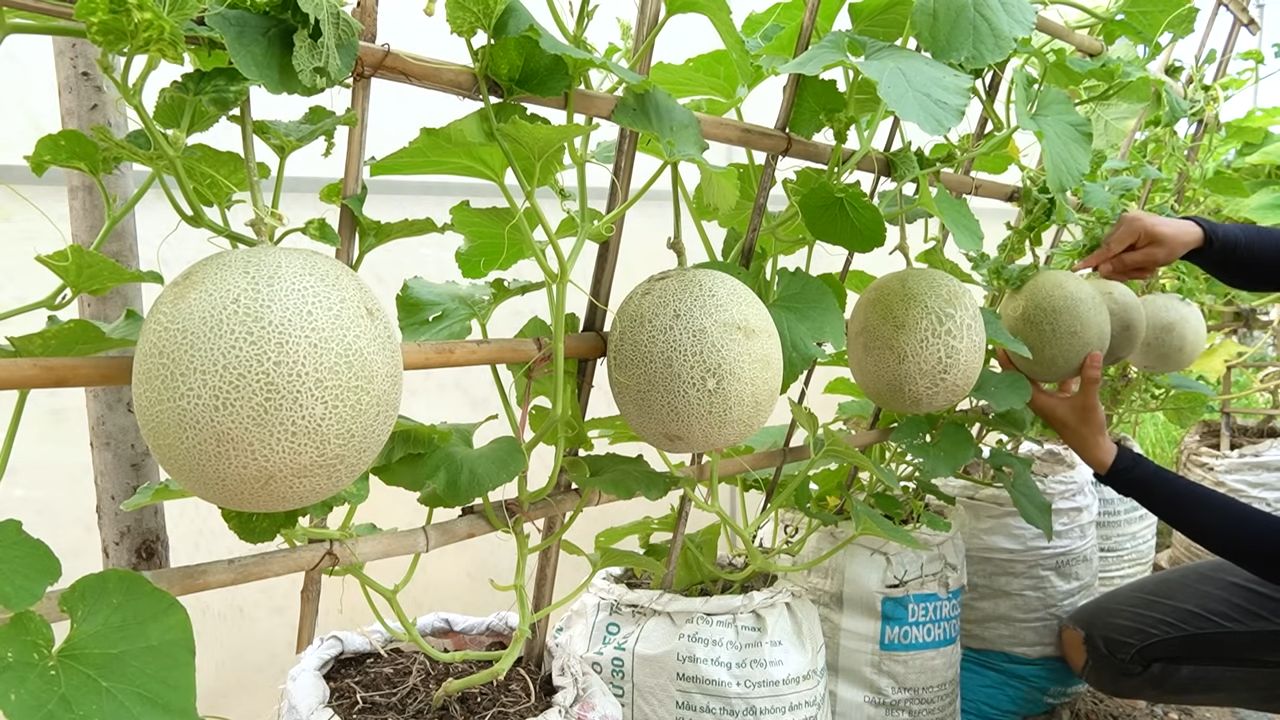
Growing Cantaloupe in Grow Bags: A Sweet Success Story!
Hey there, fellow gardening enthusiasts! I’m so excited to share my experience with growing cantaloupe in grow bags. I know, it might sound a little unconventional, but trust me, it’s a game-changer! If you’re short on space, have poor soil, or just want to try something new, growing cantaloupe in grow bags is the way to go. I’ve had some seriously delicious and surprisingly large cantaloupes using this method, and I’m here to guide you through every step.
Why Grow Bags for Cantaloupe?
Before we dive into the how-to, let’s talk about why grow bags are so fantastic for cantaloupe:
* Excellent Drainage: Cantaloupe hates soggy roots. Grow bags provide superior drainage compared to traditional containers, preventing root rot and other moisture-related issues.
* Air Pruning: The fabric of grow bags allows air to circulate around the roots. This “air pruning” encourages the plant to develop a denser, more fibrous root system, leading to better nutrient uptake and a healthier plant.
* Portability: Need to move your cantaloupe to a sunnier spot? No problem! Grow bags are lightweight and easy to move around, especially when they are smaller.
* Space Saving: Even if you have a small balcony or patio, you can still enjoy homegrown cantaloupe. Grow bags come in various sizes, allowing you to maximize your growing space.
* Temperature Regulation: Grow bags help regulate soil temperature, keeping the roots cooler in the summer heat and warmer during cooler nights.
Choosing the Right Grow Bag and Variety
Okay, let’s get down to business! The first step is selecting the right grow bag and cantaloupe variety.
* Grow Bag Size: I recommend using a grow bag that’s at least 20 gallons in size. Cantaloupe vines get quite large, and they need plenty of room for their roots to spread out. A 25-gallon or even 30-gallon bag would be even better, especially if you’re planning on growing more than one plant per bag.
* Grow Bag Material: Opt for a breathable fabric grow bag, like felt or a similar material. These materials allow for proper drainage and air circulation. Avoid plastic grow bags, as they can trap moisture and heat.
* Cantaloupe Variety: Choose a variety that’s well-suited for your climate and growing conditions. Some popular choices for container gardening include:
* ‘Sugar Cube’: A small, sweet cantaloupe that matures quickly.
* ‘Minnesota Midget’: Another compact variety that’s perfect for smaller spaces.
* ‘Hales Best Jumbo’: A classic cantaloupe with a delicious flavor.
* ‘Athena’: A disease-resistant variety that’s known for its high yields.
* ‘Charentais’: A French heirloom variety with a unique flavor and aroma.
Step-by-Step Guide to Growing Cantaloupe in Grow Bags
Alright, let’s get our hands dirty! Here’s my step-by-step guide to growing cantaloupe in grow bags:
1. Preparing the Grow Bag and Soil
* Choose a Sunny Location: Cantaloupe needs at least 6-8 hours of direct sunlight per day. Select a location that gets plenty of sun.
* Place the Grow Bag: Place your grow bag in the chosen location before filling it with soil. Once it’s full, it will be heavy and difficult to move.
* Prepare the Soil: Cantaloupe thrives in well-draining, nutrient-rich soil. I like to use a mix of:
* 50% high-quality potting mix
* 25% compost (for added nutrients)
* 25% perlite or vermiculite (for drainage)
* Fill the Grow Bag: Fill the grow bag with the soil mixture, leaving a few inches of space at the top.
2. Planting the Cantaloupe
* Starting from Seed (Optional): You can start cantaloupe seeds indoors 3-4 weeks before the last expected frost. Sow the seeds about 1 inch deep in small pots filled with seed-starting mix. Keep the soil moist and warm (around 70-80°F). Once the seedlings have a few true leaves, you can transplant them into the grow bag.
* Transplanting Seedlings: If you purchased seedlings from a nursery, gently remove them from their containers.
* Planting Depth: Dig a hole in the soil that’s slightly larger than the root ball of the seedling. Place the seedling in the hole, making sure the top of the root ball is level with the soil surface.
* Spacing: If you’re planting more than one cantaloupe plant in the grow bag, space them at least 18-24 inches apart.
* Water Thoroughly: After planting, water the seedlings thoroughly to help them settle in.
3. Providing Support for the Vines
* Trellising: Cantaloupe vines can get quite long and heavy. Providing support will help keep the fruits off the ground and prevent them from rotting. You can use a trellis, a tomato cage, or even a sturdy fence.
* Training the Vines: As the vines grow, gently train them to climb the trellis or support structure. You can use plant ties or clips to secure them.
* Fruit Support (Optional): As the cantaloupes develop, you may need to provide additional support for the fruits, especially if they are large. You can use slings made from pantyhose or netting to support the fruits and prevent them from breaking off the vine.
4. Watering and Fertilizing
* Watering: Cantaloupe needs consistent moisture, especially during hot weather. Water deeply whenever the top inch of soil feels dry to the touch. Avoid overwatering, as this can lead to root rot.
* Fertilizing: Cantaloupe is a heavy feeder, so it’s important to fertilize regularly. Use a balanced fertilizer (like 10-10-10) every 2-3 weeks. You can also supplement with compost tea or fish emulsion.
* Side-dressing: When the plants start to flower, side-dress them with a fertilizer that’s higher in phosphorus and potassium to promote fruit development. Bone meal and wood ash are good sources of these nutrients.
5. Pollination
* Hand-Pollination (If Necessary): Cantaloupe plants have separate male and female flowers. The female flowers have a small fruit behind them. If you’re not seeing any fruit development, you may need to hand-pollinate the flowers.
* How to Hand-Pollinate: Use a small paintbrush or cotton swab to collect pollen from the male flowers (the ones without the small fruit). Then, gently transfer the pollen to the stigma of the female flowers. Do this in the morning, when the flowers are open.
6. Pest and Disease Control
* Common Pests: Cantaloupe can be susceptible to pests like aphids, squash bugs, and cucumber beetles. Inspect your plants regularly for signs of infestation.
* Organic Pest Control: Use organic pest control methods, such as insecticidal soap, neem oil, or diatomaceous earth, to control pests.
* Common Diseases: Cantaloupe can also be affected by diseases like powdery mildew and fusarium wilt.
* Disease Prevention: To prevent diseases, provide good air circulation, avoid overwatering, and remove any infected leaves or plants. You can also use a fungicide if necessary.
7. Harvesting
* Signs of Ripeness: Cantaloupe is ready to harvest when it turns a golden color, the stem starts to crack near the fruit, and it has a sweet aroma.
* The “Slip Test”: The easiest way to tell if a cantaloupe is ripe is to gently tug on the stem. If the fruit slips easily off the vine, it’s ready to harvest.
* Harvesting: Use a sharp knife or pruning shears to cut the cantaloupe from the vine.
* Enjoy! Once you’ve harvested your cantaloupe, let it sit at room temperature for a few days to ripen fully. Then, chill it in the refrigerator and enjoy!
Troubleshooting Tips
* Yellowing Leaves: This could be a sign of overwatering, nutrient deficiency, or disease. Check the soil moisture, fertilize if necessary, and inspect the plants for signs of disease.
* Lack of Fruit: This could be due to poor pollination, lack of nutrients, or stress. Hand-pollinate the flowers, fertilize regularly, and make sure the plants are getting enough sunlight and water.
* Small Fruits: This could be due to lack of nutrients or water. Fertilize regularly and water deeply, especially during hot weather.
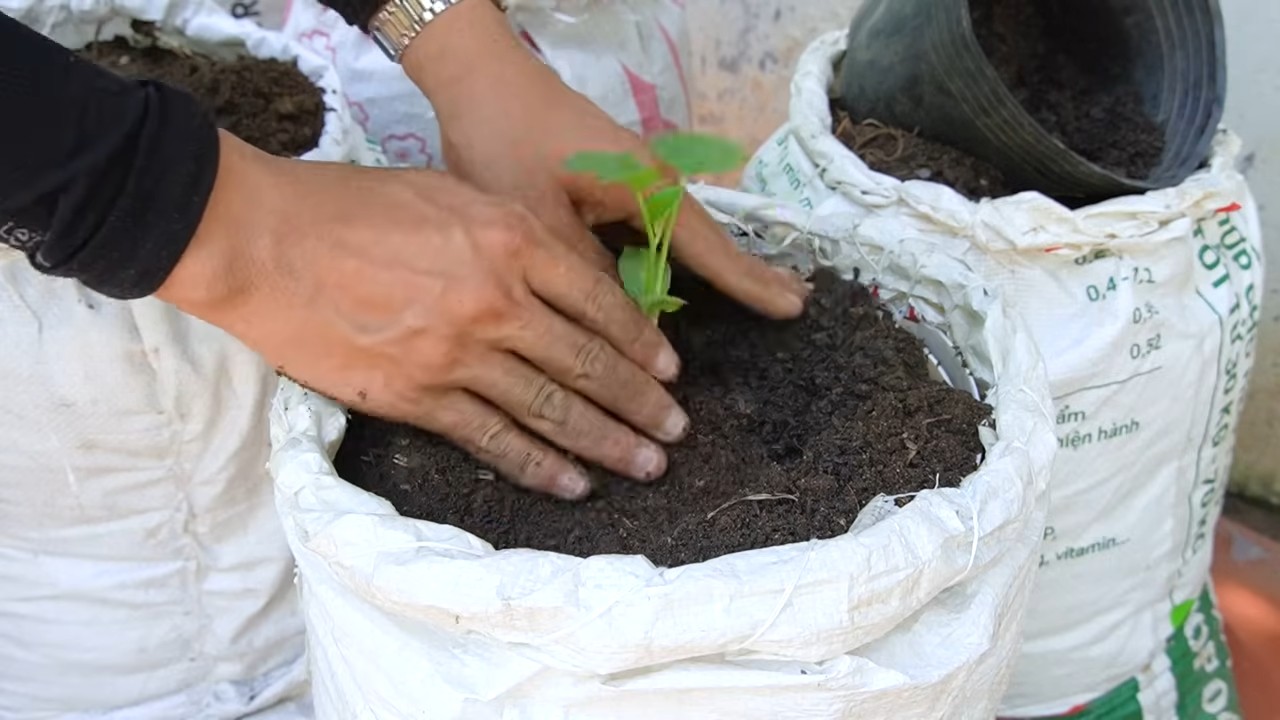
Conclusion
So, there you have it! Growing cantaloupe in grow bags isn’t just a gardening trend; it’s a game-changer for anyone looking to enjoy the sweet, juicy taste of homegrown cantaloupe, regardless of their space constraints or soil conditions. We’ve walked through the entire process, from selecting the right grow bag and preparing the perfect soil mix to nurturing your cantaloupe vines and harvesting your delicious bounty.
Why is this DIY trick a must-try? Because it democratizes cantaloupe cultivation! No longer are these delectable melons reserved for those with sprawling gardens and perfectly balanced soil. Grow bags provide a controlled environment, allowing you to optimize drainage, temperature, and nutrient delivery, leading to healthier plants and more abundant yields. Plus, the portability of grow bags means you can chase the sun, moving your cantaloupe plants to the sunniest spot in your yard throughout the day. This is especially beneficial in areas with shorter growing seasons or unpredictable weather.
But the beauty of this method lies in its adaptability. Feel free to experiment with different cantaloupe varieties. While we’ve focused on classic cantaloupe, consider trying smaller, personal-sized varieties like ‘Sugar Cube’ or ‘Minnesota Midget’ if you’re limited on space. You can also explore different companion planting options. Marigolds, for example, are known to deter pests, while basil can improve the flavor of your cantaloupe. Don’t be afraid to get creative with your trellis system, either. While a simple A-frame trellis works well, you can also use tomato cages or even repurpose old ladders to provide support for your growing vines.
Consider adding a slow-release fertilizer specifically formulated for melons to your soil mix at planting time. This will provide a steady stream of nutrients throughout the growing season. You can also supplement with liquid fertilizer every few weeks, especially during the fruiting stage. Remember to monitor your plants regularly for signs of pests or diseases. Early detection is key to preventing problems from escalating.
And speaking of problems, don’t be discouraged if you encounter a few bumps along the road. Gardening is a learning process, and even experienced gardeners face challenges. The key is to stay observant, adapt your approach as needed, and never give up on your dream of enjoying homegrown cantaloupe.
Ultimately, growing cantaloupe in grow bags is a rewarding experience that connects you with nature and provides you with a delicious, healthy treat. It’s a testament to the fact that with a little ingenuity and effort, anyone can enjoy the fruits (or rather, melons) of their labor.
So, what are you waiting for? Grab a grow bag, some seeds, and get ready to embark on your cantaloupe-growing adventure! We’re confident that you’ll be amazed by the results. And when you do, we want to hear all about it! Share your experiences, tips, and photos with us in the comments below. Let’s build a community of cantaloupe enthusiasts and inspire others to discover the joy of growing their own food. We are excited to see your success in **growing cantaloupe in grow bags**. Happy gardening!
Frequently Asked Questions (FAQ)
What size grow bag is best for cantaloupe?
A 15-20 gallon grow bag is generally recommended for growing cantaloupe. This size provides ample space for the roots to develop and support the vigorous growth of the vine. Smaller grow bags may restrict root growth, leading to smaller melons and reduced yields.
What kind of soil should I use in my grow bag?
Cantaloupe thrives in well-draining, nutrient-rich soil. A good mix consists of equal parts compost, potting soil, and perlite or vermiculite. The compost provides essential nutrients, the potting soil retains moisture, and the perlite or vermiculite improves drainage and aeration. Avoid using garden soil, as it can be too heavy and compact, hindering root growth.
How often should I water my cantaloupe plants in grow bags?
Watering frequency depends on the weather, the size of the grow bag, and the stage of plant growth. Generally, you should water deeply whenever the top inch of soil feels dry to the touch. During hot, dry weather, you may need to water daily. Avoid overwatering, as this can lead to root rot. Ensure the grow bag has adequate drainage to prevent waterlogging.
Do I need to fertilize my cantaloupe plants in grow bags?
Yes, cantaloupe plants are heavy feeders and require regular fertilization. Start with a slow-release fertilizer at planting time, and then supplement with a liquid fertilizer every 2-3 weeks during the growing season. Choose a fertilizer that is high in phosphorus and potassium, as these nutrients are essential for fruit development.
How do I know when my cantaloupe is ripe?
Several indicators can help you determine when your cantaloupe is ripe. The skin will change color from green to a tan or yellowish hue. The stem will begin to crack and separate easily from the vine (this is called “slipping”). The melon will also emit a sweet, musky aroma. Gently press on the blossom end of the melon; it should feel slightly soft.
What are some common pests and diseases that affect cantaloupe?
Common pests include aphids, squash bugs, and cucumber beetles. Diseases include powdery mildew, fusarium wilt, and downy mildew. Regularly inspect your plants for signs of pests or diseases. Treat infestations promptly with insecticidal soap or neem oil. Prevent diseases by providing good air circulation, avoiding overhead watering, and using disease-resistant varieties.
Can I grow cantaloupe in grow bags in a greenhouse?
Yes, growing cantaloupe in grow bags in a greenhouse is an excellent option, especially in areas with short growing seasons. The greenhouse provides a controlled environment, allowing you to extend the growing season and protect your plants from harsh weather. Ensure the greenhouse has adequate ventilation and sunlight.
How do I support the cantaloupe vines in grow bags?
Cantaloupe vines can become quite heavy, so it’s essential to provide adequate support. Use a trellis, tomato cage, or other support structure to keep the vines off the ground. This will improve air circulation, reduce the risk of disease, and make it easier to harvest the melons. You may also need to support the melons themselves as they grow larger, using slings made from pantyhose or netting.
Can I reuse grow bags for growing cantaloupe?
Yes, grow bags can be reused for several seasons. After harvesting your cantaloupe, remove the old plant material and wash the grow bag thoroughly with soap and water. Allow the bag to dry completely before storing it. You may also want to amend the soil with fresh compost before reusing it.
What are the benefits of growing cantaloupe in grow bags compared to traditional gardening?
Growing cantaloupe in grow bags offers several advantages over traditional gardening. It allows you to control the soil quality and drainage, which is crucial for cantaloupe growth. Grow bags are also portable, so you can move your plants to the sunniest spot in your yard. They are ideal for small spaces, such as balconies or patios. Additionally, grow bags reduce the risk of soilborne diseases and pests.
How many cantaloupe plants can I grow in one grow bag?
It is generally recommended to grow only one cantaloupe plant per 15-20 gallon grow bag. This ensures that each plant has enough space to develop a strong root system and produce healthy melons. Overcrowding can lead to stunted growth and reduced yields.
What if my cantaloupe plant is not producing fruit?
Several factors can contribute to a lack of fruit production in cantaloupe plants. These include insufficient pollination, inadequate sunlight, nutrient deficiencies, and stress from pests or diseases. Ensure your plants are receiving at least 6-8 hours of sunlight per day. Hand-pollinate the flowers if necessary. Fertilize regularly with a balanced fertilizer. And address any pest or disease problems promptly.
How do I hand-pollinate cantaloupe flowers?
Cantaloupe plants have separate male and female flowers. To hand-pollinate, use a small paintbrush or cotton swab to collect pollen from the male flowers (which have a long, thin stem). Then, transfer the pollen to the female flowers (which have a small, immature fruit at the base). Repeat this process for several days to ensure pollination.
What is the best time of year to start growing cantaloupe in grow bags?
The best time to start growing cantaloupe in grow bags is after the last frost, when the soil has warmed up to at least 60°F (15°C). You can start seeds indoors 4-6 weeks before the last frost and then transplant them into grow bags once the weather is warm enough.
How long does it take to grow cantaloupe in grow bags?
Cantaloupe typically takes 70-90 days to mature from seed to harvest. The exact time will depend on the variety, the weather, and the growing conditions. Be patient and monitor your plants regularly for signs of ripeness.


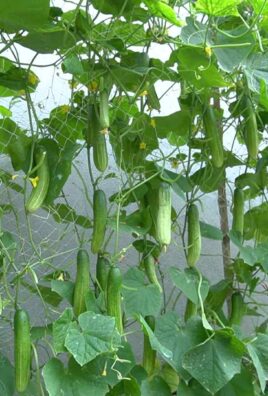
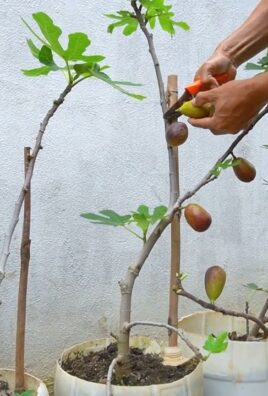
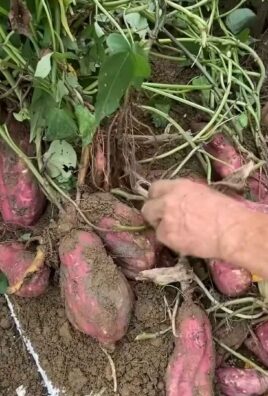
Leave a Comment